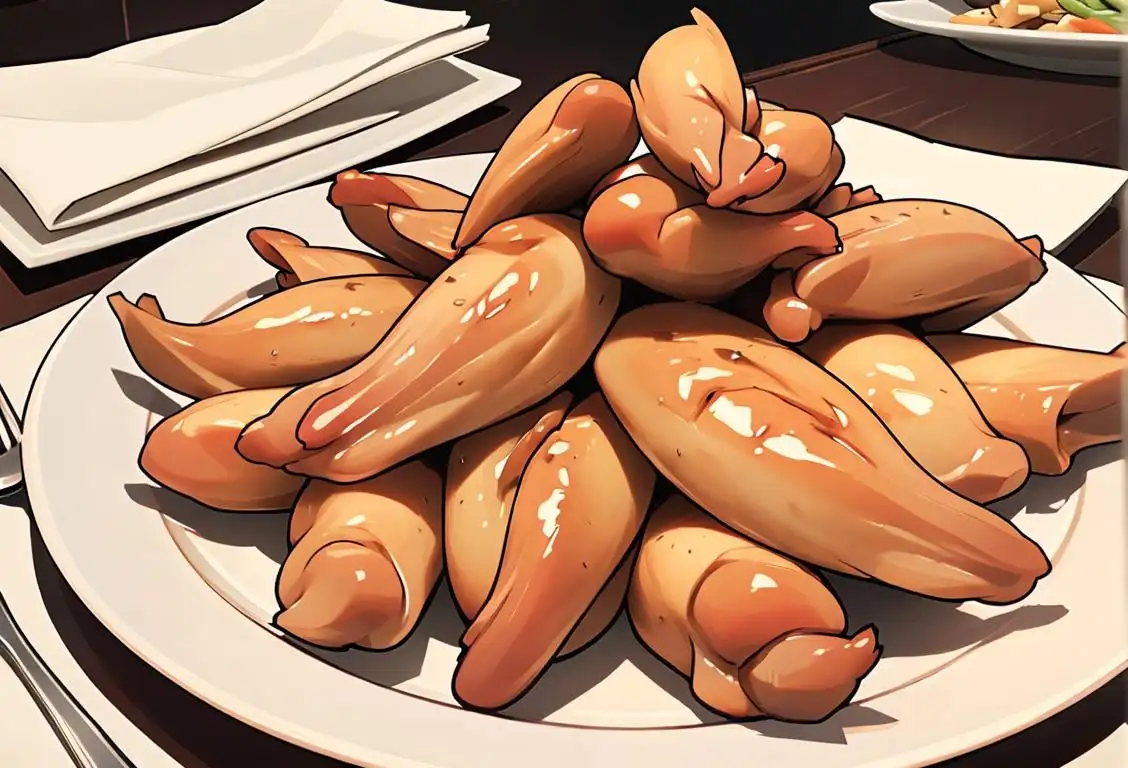National Jamaican Beef Patty Day

Welcome to National Jamaican Beef Patty Day, a day to celebrate the delicious and savory Jamaican treat that makes your taste buds dance with joy! Get ready to learn all about the history and significance of this delectable dish.
When is Jamaican Beef Patty Day?
It's national jamaican beef patty day on the 1st August.
The Birth of Jamaican Beef Patty Day
National Jamaican Beef Patty Day is a relatively new addition to the calendar of food celebrations. It all started on August 1, 2015, when social media exploded with mentions of this mouthwatering delicacy. People couldn't help but share their love for the Jamaican beef patty, making it an instant hit in the online world.
Legend has it that a group of Jamaican food enthusiasts decided to create a special day dedicated to their favorite handheld snack. They wanted to spread awareness about the rich culinary heritage of Jamaica and the uniqueness of their beloved beef patty.
Word quickly spread, and before anyone knew it, National Jamaican Beef Patty Day was born. Now, every year on August 1st, people from all walks of life celebrate this iconic Jamaican dish.
What Makes Jamaican Beef Patty Special?
Now, you might be wondering what sets the Jamaican beef patty apart from your average meat-filled pastry. The answer lies in the flavor and spices.
Traditionally, the filling consists of minced beef, onions, garlic, and a fiery blend of Jamaican spices. The most important ingredient that gives the patty its distinct taste is Scotch bonnet pepper. Be warned, though – this little pepper packs a spicy punch!
Another unique feature of the Jamaican beef patty is its golden, flaky crust. The pastry dough gets its vibrant yellow color from turmeric, which also adds a subtle hint of flavor.
Celebrating National Jamaican Beef Patty Day
There are countless ways to celebrate National Jamaican Beef Patty Day. You can start by indulging in this Jamaican delicacy yourself. Head to a local Jamaican restaurant or bakery and immerse yourself in a burst of flavors.
If you fancy yourself a home cook, why not try making your own Jamaican beef patties? With a little bit of practice, you can become the next Jamaican beef patty master chef!
Don't forget to share your culinary creations on social media using the hashtag #JamaicanBeefPattyDay. Let the world know how much you adore this beloved snack!
History behind the term 'Jamaican Beef Patty'
1655
British Colonization of Jamaica
In the year 1655, Jamaica was captured by the British during the Anglo-Spanish War. This marked the beginning of British colonization in Jamaica. The British influence on Jamaican cuisine would later play a significant role in the creation of the Jamaican beef patty.
1920
Introduction of patty concept
The concept of the patty can be traced back to the early 20th century. It originated in Cornwall, England, where a traditional meat pie called the Cornish pasty was popular. This pastry filled with meat, vegetables, and spices soon traveled to other parts of the world through British colonization.
20th century
Introduction of Jamaican patty
Jamaican patties made their debut in the early 20th century when Chinese immigrants in Jamaica adapted their traditional empanada-like pastries to local tastes. These immigrants owned bakeries that started selling patties filled with various ingredients like beef, chicken, or vegetables. The delicious blend of flavors quickly gained popularity among the Jamaican population.
1780
The Introduction of Jamaican Patties
Jamaican patties have their roots in West Africa, where a similar pastry known as the 'pate' was commonly eaten. The patties were introduced to Jamaica during the transatlantic slave trade. Enslaved West Africans brought their culinary traditions to the Caribbean, including the concept of a savory meat-filled pastry. These early versions of Jamaican patties were often made with fish or vegetables.
1780
The Arrival of Jamaican Patties in the Caribbean
During the 18th century, Jamaican patties, also known as meat patties, were introduced to the Caribbean. These delicious savory pastries featured a flaky crust filled with spiced minced meat, usually beef, and various other ingredients such as onions, peppers, and spices. The Jamaican patties quickly gained popularity among the locals and became a staple in Caribbean cuisine.
1780
The Early Beginnings
Jamaican beef patties have a rich history that dates back to the late 18th century. During this time, Jamaican immigrants began arriving in the United States, bringing with them their culinary traditions. The concept of a meat-filled pastry, similar to a patty, was already popular in Jamaica, but it was in the United States that it started to gain recognition as a distinct dish.
1783
Jamaica gains independence
In 1783, the British officially granted independence to Jamaica. This significant event would shape the future of the nation, including its cuisine.
1655
The British takeover of Jamaica
In 1655, the British invaded and captured Jamaica from Spanish control. With this conquest, the British brought their culinary influences and ingredients to the island, which would eventually shape the Jamaican beef patty.
1900s
Cultural fusion inspires new dishes
During the early 1900s, Jamaica saw an influx of immigrants from various cultural backgrounds, such as China and India. This cultural fusion led to the creation of new dishes that combined traditional Jamaican flavors with influences from these immigrant communities.
1940
The Shift to Beef Patties
In the 1940s, beef became more widely available in Jamaica due to increased cattle farming. This led to a shift in the main ingredient of Jamaican patties from fish or vegetables to beef. The introduction of beef patties was well-received and quickly gained popularity among Jamaicans, becoming a staple of the local cuisine.
18th century
Introduction of Cornish pasties
During the 18th century, Cornish pasties gained popularity in England. These pastries, typically filled with meat and vegetables, became a staple among miners as a convenient and hearty meal. The Cornish pasty would later serve as the inspiration for the Jamaican beef patty.
1950
The name 'Jamaican Beef Patty'
In 1950, a Jamaican-born restaurateur named Tastee Patties opened the first fast-food patty shop in Kingston, Jamaica. Tastee Patties named their signature dish 'Jamaican Beef Patty' to reflect the local origins and primary filling of seasoned ground beef. This marked a significant milestone in establishing the term 'Jamaican Beef Patty' as a recognized and beloved national food.
1940
Jamaican influence on the patty
In the 1940s, during the wave of Jamaican migration to the United States and other countries, Jamaican immigrants brought their own unique twist to the patty. They incorporated flavors and spices characteristic of Jamaican cuisine, such as scotch bonnet peppers, thyme, and allspice. This created the distinct taste that we associate with Jamaican beef patties today.
1940
Birth of the Jamaican Beef Patty
It was in the 1940s that the Jamaican beef patty as we know it today truly came into prominence. A Jamaican baker by the name of Tastee Patties is credited with creating and popularizing the modern version of the Jamaican beef patty. Tastee Patties, founded by Vincent and Evelyn Chang, began selling their delectable meat-filled pastries in Kingston, Jamaica.
18th Century
Arrival of Cornish Pasty
During the 18th century, Cornish Pasties gained popularity in England. These savory pastries were a staple among the working class and typically filled with meat, potatoes, and vegetables. The Cornish Pasty's influence can be seen in the development of the Jamaican beef patty's pastry crust.
1940
The Creation of the Jamaican Beef Patty
In the 1940s, the Jamaican beef patty as we know it today was born. It is said that a Jamaican baker named Tastee Patties, located in Kingston, Jamaica, was the first to mass produce and sell this delectable pastry. The company revolutionized the patty by incorporating a uniquely spiced beef filling sealed within a golden pastry shell. The patty quickly became an iconic Jamaican food, loved by locals and visitors alike.
1940s
Introduction of the patty concept
In the 1940s, the concept of the Jamaican beef patty began to take shape. Inspired by English meat pies, the patty was introduced as a convenient and portable snack, ideal for the busy working class population.
1963
Tastee Patty's Impact
In 1963, Tastee Patty, a well-known Jamaican fast-food chain, was founded. They played a significant role in popularizing the Jamaican beef patty both within Jamaica and beyond. With their consistent quality and delicious flavors, Tastee Patty became synonymous with Jamaican beef patties and expanded their reach to international markets.
1960
Rise of the Jamaican Patty Industry
During the 1960s, several Jamaican entrepreneurs recognized the market potential of Jamaican patties and started commercializing their production. These entrepreneurs established patty bakeries and established the Jamaican patty as a recognizable and widely available snack. The patties were often sold in small shops or from street food vendors.
Early 20th Century
Indian Influence on Jamaican Cuisine
In the early 20th century, Jamaican cuisine experienced a significant influence from Indian immigrants who settled on the island. Indian spices and flavors began to merge with traditional Jamaican ingredients, resulting in a unique fusion of culinary traditions.
1960
Expansion of Jamaican Beef Patties in the United States
In the 1960s, with the increase in Jamaican immigration to the United States, the popularity of Jamaican beef patties began to spread. Jamaican entrepreneurs, such as Vincent HoSang, started exporting frozen Jamaican beef patties to the U.S. market. The patties gained a dedicated following, especially in areas with large Caribbean communities.
1965
Expansion to the United States
In 1965, Tastee Patties expanded beyond Jamaica and opened its first overseas location in Miami, Florida. This marked the introduction of Jamaican beef patties to a wider audience outside of Jamaica. The unique combination of flaky pastry and flavorful spiced beef quickly gained popularity among locals and tourists alike.
1970s-1980s
Growth of Jamaican patty in United States
As Jamaican immigrants started to settle in the United States during the 1970s and 1980s, they brought their culinary traditions with them, including the beloved Jamaican Beef Patty. Jamaican restaurants, food trucks, and bakeries sprung up in cities like New York, Miami, and Los Angeles, offering authentic Jamaican patties to a wider audience. This led to the spread of Jamaican Beef Patty's popularity beyond Jamaica's borders.
20th century
Indian and African influences
In the 20th century, Jamaica experienced an influx of Indian and African immigrants, who brought their own culinary traditions. The melding of these diverse influences led to the creation of new flavors and dishes within Jamaican cuisine, including the development of the Jamaican beef patty.
Present
Global recognition and variations
In the present day, the term 'Jamaican Beef Patty' has gained global recognition as a delicious and iconic Jamaican street food. Throughout the years, the original concept of a flaky pastry filled with savory meat or vegetable filling has evolved, giving rise to various regional and international variations. It has become a versatile snack found in Caribbean communities worldwide, with countless creative fillings and flavor combinations.
1978
Golden Krust's Contribution
In 1978, Golden Krust Caribbean Bakery & Grill was established in the Bronx, New York. Founded by Jamaican immigrants, Golden Krust became one of the largest Caribbean food franchise chains in the United States. They played a crucial role in introducing Jamaican beef patties to a wider audience and making them a popular street food in New York City.
1940s
Jamaican Patty Emerges
In the 1940s, the Jamaican beef patty as we know it today began to take shape. The flaky pastry crust from the Cornish Pasty was combined with the spicy and flavorful fillings inspired by Indian cuisine. The traditional Cornish Pasty filling of meat and vegetables was replaced with a spiced ground beef filling, often seasoned with Scotch bonnet peppers and other aromatic spices.
1976
Golden Krust Bakery & Grill
Golden Krust Bakery & Grill, founded by Jamaican immigrants Lowell and Mavis Hawthorne in 1976, played a significant role in popularizing Jamaican beef patties in the United States. The company opened its first location in the Bronx, New York, and focused on producing and distributing authentic Jamaican food, including the beloved beef patties. Their success paved the way for more Jamaican food establishments to introduce the dish to Americans across the country.
1978
Establishment of National Jamaican Patty Day
In 1978, the Caribbean Food Delights company, founded by Vincent HoSang, established National Jamaican Patty Day in New York City. This annual celebration, which takes place on the first Saturday in August, aims to honor the Jamaican beef patty and its cultural significance. The event features various festivities, including music, dance, and of course, plenty of delicious Jamaican beef patties.
Late 20th Century
Cultural Influence and Globalization
As Jamaican communities formed abroad, particularly in cities like New York and London, the popularity of Jamaican patties spread beyond the island. Jamaican restaurants and bakeries became cultural hubs, serving traditional Jamaican cuisine including the iconic beef patties. The unique flavor and flaky pastry of the Jamaican patty have won over people from various cultural backgrounds, making it a beloved international snack.
1940s
Birth of the Jamaican beef patty
It is widely believed that the Jamaican beef patty was born in the 1940s. Tastebuds, a popular Jamaican bakery, is credited with introducing the modern version of the patty. They transformed the traditional Cornish pasty concept by incorporating Jamaican flavors, such as thyme and scotch bonnet peppers, into the pastry and filling.
1960s
Mass production and popularity
During the 1960s, the Jamaican beef patty underwent mass production, making it more accessible to the general population. Its affordability and delicious taste quickly gained popularity, solidifying its place as a beloved Jamaican staple.
Present
Popularity and Variations
Today, Jamaican beef patties are widely enjoyed around the world. They have become a symbol of Jamaican cuisine and cultural identity. While the traditional beef patty remains popular, there are also variations available, such as chicken, vegetable, and even vegan options. Jamaican beef patties are often served with a side of spicy sauce or enjoyed as a filling snack or meal on their own.
1960s
Expansion and Commercialization
During the 1960s, the Jamaican beef patty gained popularity across Jamaica and began to be sold by street vendors and bakeries. It quickly became a beloved staple of Jamaican cuisine. The commercial production and distribution of Jamaican beef patties further contributed to their accessibility and popularity.
1950s
Expansion and popularity
In the 1950s, the Jamaican beef patty gained widespread popularity among locals and visitors alike. These delicious, handheld treats became a staple street food and a symbol of Jamaican culinary culture. Today, you can find Jamaican beef patties in various forms, enjoyed not only in Jamaica but also in many other countries around the world.
1990s
Global popularity
By the 1990s, Jamaican beef patties had gained international popularity. The unique blend of spices, flaky crust, and savory filling had captivated taste buds around the world. They became a staple in Caribbean cuisine and could be found in various countries, from the United Kingdom to Canada, and even in Caribbean communities in Africa and Asia.
1985
The Rise of Frozen Patties
In the mid-1980s, frozen Jamaican beef patties started to gain popularity. Companies like Tower Isle's Patties and Royal Caribbean Bakery began producing packaged frozen patties, allowing people to enjoy this delicious treat at home. The convenience and availability of frozen patties contributed to their increased consumption and recognition in the United States.
1976
Golden Krust franchise introduces the patty to the USA
In 1976, the Golden Krust bakery franchise was founded, becoming the first major Jamaican beef patty supplier in the United States. This expansion helped introduce the patty to a wider audience, further popularizing it outside of Jamaica.
Present
Global Recognition and Variations
Today, Jamaican beef patties have gained global recognition as a delicious and iconic Jamaican dish. They can be found not only in Jamaica and the United States but also in various Caribbean communities and international cities with diverse populations. Additionally, the original beef filling has expanded to include other options such as chicken, vegetable, and even vegan variations, catering to different dietary preferences and cultural cuisines.
Present Day
Global Recognition
Today, Jamaican beef patties have gained global recognition and are enjoyed by people all around the world. Whether in Jamaica or abroad, these delicious pastries with their flavorful fillings continue to be a symbol of Jamaican culinary heritage and cultural diversity.
Did you know?
Did you know that Jamaican beef patties have roots tracing back to Cornish pasties? When Jamaican immigrants arrived in the Caribbean, they brought with them their love for the meat-filled pastry. Over the years, the recipe evolved to include local ingredients and spices, giving birth to the Jamaican beef patty as we know it today.Tagged
awareness food funFirst identified
1st August 2015Most mentioned on
1st August 2015Total mentions
5Other days
Sweet Tea Day
Agriculture Day
Cheese Pizza Day
Bacon Day
Pumpkin Day
Medal Of Honor Day
Vodka Day
Foundation Day
Guac Day
Wing Day









